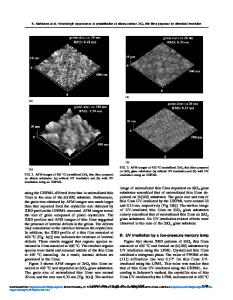Crystallization of Silicon thin Films Prepared by ECR PECVD
- PDF / 699,090 Bytes
- 6 Pages / 414.72 x 648 pts Page_size
- 92 Downloads / 388 Views
ABSTRACT Silicon thin films were deposited by Electron Cyclotron Resonance PECVD using silane as a source gas at room temperature. Deposited films were crystallized either by conventional furnace annealing(FA) or by rapid thermal annealing(RTA) process. The films deposited on SiO 2/Si wafer substrates were amorphous or microcrystalline depending on the microwave power. Deposited films were annealed at 6001C in a furnace. As expected, higher crystallinity was obtained in the case of the amorphous films than the microcrystalline films after 7.5 hours annealing. It took 15 hours at 6001C for the amorphous films to reach their maximum crystallinity in case of FA, but it only took 1 second at 9001C for RTA. In addition, it was shown that RTA can be applied to the rapid crystallization of amorphous silicon thin films deposited on a fused quartz substrate utilizing a new film structure.
INTRODUCTION In the field of Active Matrix Liquid Crystal Displays, recently, poly-Si thin film transistors(TFTs) have received considerable attention because of their many advantages over a-Si TFTs such as a higher field effect mobility and a lower photoconductivity. Poly-Si TFTs have been fabricated by various methods, among which the crystallization of amorphous silicon films deposited by Low Pressure Chemical Vapor Deposition or Plasma Enhanced Chemical Vapor Deposition(PECVD) and the deposition of poly crystalline silicon films are typical methods[1,2]. The former has been preferred because the usage of inexpensive glass limits the process temperature, and solid phase crystallization(SPC) has been widely studied rather than the other methods[3]. One of the weaknesses of SPC, however, is that it takes a long time. Rapid Thermal Annealing(RTA) process has made a great progress in Si processing field because of its high throughput and ability to preferentially raise the surface temperature, but few reports its usage[41 in the field of poly-Si TFTs due to the low absorption coefficient of silicon in visible region. Electron Cyclotron Resonance(ECR) PECVD is currently attracting much attention because of its lack of electrode and its ability to create high densities of 4 charged and excited species at low pressure(
Data Loading...
